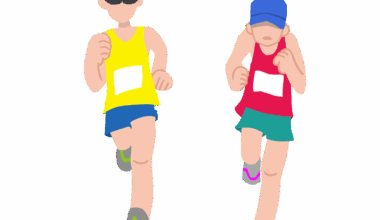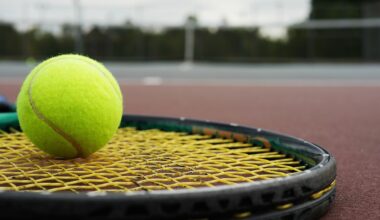The History and Evolution of Dance Aerobics as a Sport
Dance aerobics emerged in the late 20th century as a dynamic fusion of dance and fitness, captivating audiences worldwide. The concept gained momentum in the 1960s when fitness instructors began to incorporate rhythmic movements into traditional aerobics. Pioneers like Jacki Sorensen and Judi Sheppard Missett transformed the exercise landscape, championing the idea that working out could be fun and social. By integrating popular dance styles, they created energetic routines that appealed to diverse individuals. The cultural roots of dance aerobics can be traced to jazzercise, which encouraged participants to express themselves through movement. This innovative approach attracted a broad demographic, making fitness accessible and enjoyable. The vibrant nature of dance aerobics often leads to community-building, where individuals gather not only to exercise but also to create social connections. In this space, members forge friendships, providing each other motivation. Fitness trends evolved, leading to various styles, such as Zumba and hip-hop aerobics, that kept the essence of dance aerobics alive. As time progressed, the industry witnessed choreographers, dancers, and fitness enthusiasts pushing the boundaries of creativity in movement-centric workouts.
Throughout the years, several elements have shaped dance aerobics into what it embodies today. The incorporation of music has remained a crucial factor, dictating the pace and energy of routines. Disco and hip-hop beats set the stage for exhilarating classes, ensuring participants remain engaged and energized. Dance aerobics classes often feature a mix of genres, including Latin, hip-hop, and pop, making workouts relatable and enjoyable. Through this eclectic blend of music, participants connect emotionally with routines, making every session a holistic experience. Moreover, the accessibility of dance aerobics has expanded significantly, with online classes gaining popularity, especially during the recent pandemic. This shift enabled individuals to practice at home, ensuring the community remains connected despite geographical distance. Social media platforms have further amplified this phenomenon, enabling enthusiasts to share progress, tips, and positivity. Consequently, communities all around the world have sprung from this shared passion for fitness. This evolution has not only increased popularity but also fostered engagement among diverse populations. Dance aerobics has become a versatile platform for fitness education, inspiring new generations to embrace the joy of movement.
The Role of Technology
Technology has played a pivotal role in transforming the dance aerobics landscape, offering new avenues for creativity and accessibility. Fitness apps, online platforms, and virtual classes have made it possible for enthusiasts to participate in dance aerobics from anywhere. With smartphone applications, users can track their progress, set fitness goals, and connect with like-minded individuals to stay motivated. This interconnectedness allows for a vibrant global community where feedback and encouragement flow seamlessly. Moreover, technological advancements have enhanced the choreography behind routines, enabling instructors to produce high-quality video content with elaborate visuals and sound. Live-streaming workouts and on-demand classes provide flexibility for participants, catering to busy lifestyles. This adaptability has been fundamental in maintaining interest and participation in dance aerobics. As technology continues to evolve, future prospects include artificial intelligence (AI) coaching systems. These systems can personalize workouts based on individual preferences, ensuring maximum engagement and effectiveness. This technological integration not only benefits instructors but also enhances the accountability of participants, thus motivating them to reach their fitness goals consistently. The fusion of technology and movement continues to redefine how communities experience and interact with dance aerobics.
In the modern fitness world, the role of dance aerobics has grown more prominent within group fitness settings, reflecting societal changes toward exercise. Many gyms and studios now offer specialized classes that cater to various demographics, ensuring inclusivity. These sessions vary in intensity, duration, and complexity of movements, appealing to beginners and advanced participants alike. This diversified approach fosters a welcoming environment where everyone feels comfortable participating. Additionally, outreach programs that target schools, community centers, and senior care facilities further promote dance aerobics as an accessible form of exercise. Engaging younger generations within schools helps develop healthy habits early on, combining physical fitness and teamwork through fun, interactive classes. Similarly, adaptations for seniors focus on gentler movements that support balance and coordination while encouraging social interaction among participants. Such initiatives cumulatively promote wellness, connecting communities through fitness and encouraging a lifelong commitment to active living. This evolution illustrates the resilience of dance aerobics, adapting to meet societal needs while fostering connections and camaraderie in the pursuit of better health.
The Impact on Mental Health
The mental health benefits associated with dance aerobics cannot be understated, as numerous studies have highlighted the positive impact of exercise on emotional well-being. Participants often report increased feelings of happiness and reduced stress following dance aerobics classes due to the release of endorphins. The rhythmic movements combined with uplifting music create an enjoyable environment that promotes self-expression and escapism from daily challenges. Furthermore, engaging in group classes fosters a sense of belonging, which is essential for mental health. The communal aspect helps individuals who may struggle with isolation or loneliness to connect. Research indicates that social support contributes substantially to emotional resilience, enhancing the joy of participants while they engage in physical activity. Dance aerobics also cultivates mindfulness, as individuals concentrate on movements and beat synchronization, leading to momentary distractions from life stressors. The incorporation of dance brings creativity into exercise routines, allowing participants to explore their artistic potential while working out. This balanced fusion of fitness and fun consistently attracts new individuals to dance aerobics, spreading awareness of its mental health advantages and supporting personal growth.
As dance aerobics continues to evolve, choreography has become more intricate, reflecting the cultural influences of dance from around the globe. Instructors today draw inspiration from diverse genres such as ballet, salsa, and contemporary dance, producing innovative routines that keep participants engaged. This blend enables individuals to explore their artistic side while improving coordination and cardiovascular fitness. Additionally, showcasing various dance styles fosters cultural appreciation and understanding, promoting unity in diversity within fitness communities. Events such as dance aerobics competitions have emerged, highlighting the dedication and talent of instructors and participants alike. These competitions celebrate creativity and help refine skills, motivating communities to enhance their dance techniques further. Moreover, collaboration among instructors allows for knowledge-sharing, leading to unique class formats that keep fitness fresh and exciting. As the world of dance aerobics expands, various artistic performances and showcases emerge, allowing participants to demonstrate their skills and showcase their journey. This emphasizes the sport’s competitive elements, opening new avenues for self-expression while staying true to its core tenets of fitness and community support.
Conclusion
In conclusion, dance aerobics has transformed from a simple exercise routine into a dynamic sport promoting health, community, and creativity. Through its rich history, technological integration, and commitment to mental well-being, it continues to captivate individuals from all walks of life. This evolution highlights the resilience and adaptability of dance aerobics, making it a fit for varying lifestyles and preferences. As the need for fitness options that focus on enjoyment and social interaction grows, so too will the popularity and prominence of dance aerobics. The journey of dance aerobics is far from over, as ongoing innovations promise a bright future. Its ability to blend different cultural influences, connect communities, and enhance physical and mental health solidifies its place as a cherished practice worldwide. Encouraging people to embrace motion as a joyful expression fosters a purpose beyond just physical fitness. Ultimately, the spirit of dance aerobics embodies inclusivity, creativity, and resilience, ensuring the sport continues to thrive for generations. This unique blend of athleticism and artistry creates a haven that champions health, connection, and celebration.


